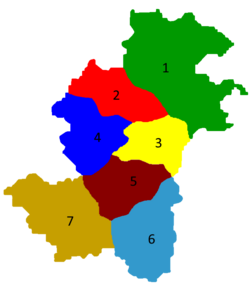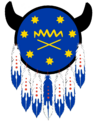The Meoquanee
The Meoquanee
ᎠᏥᏏ ᏍᎦᏯᏓ Great Meoquanee Nation | |
|---|---|
Tribal Confederation | |
|
| |
 | |
| Confederated | TBA |
| Government | |
| • Type | Tribal Council |
| • Council | Council of Seven Fires |
| Population (2018) | |
| • Total | 505,021 |
| Demonym | Meoquanee |
| Time zone | UTC−06:00 (CST) |
| • Summer (DST) | UTC−05:00 (CDT) |
The Meoquanee (Meoquanee:ᎠᏥᏏ ᏍᎦᏯᏓ'''), also known as the Great Meoquanee Nation, is a a multi-tribal confederation comprising Native and First Nations peoples who share a common linguistic and cultural heritage known as Meoquanee. The Meoquanee Nation is governed by a Grand Council referred to as the Council of Seven Fires which is composed of representatives from each of the member tribes. the Confederation is organized into matrilineal clans, which are family groups based on the maternal line of descent. In this, chiefs can be removed from their positions by the women of the tribe.
Etymology
Meoquanee (ᎠᏥᏏ ᏍᎦᏯᏓ) is the term used by the Seven Nations to collectively identify themselves. however the origins of the name are somewhat obscure. The phrase "ᎠᏥᏏ ᎠᏍᎦᏯᏗ" is transliterated as "atsilv asgaya'di," which translates to "Great Union" in English.
History
Tribal Groups
Despite its name, the Meoquanee Nation actually consists of seven distinct nations, each characterized by its own cultural traditions and governance systems.
Nations
| English name | Meoquanee name | Meaning |
|---|---|---|
| Nasawi | ᎾᏣᏫ | "People of the Heart" |
| Wyanwa | ᏪᎾᏩ | "People of the Brotherhood" |
| Kathanti | ᎧᏚᏔᏂ' | "People of Giving Thanks" |
| Aelamet | ᎠᏆᎳᎺᏝ | "People of Love" |
| Nahara | ᎾᎲᎳ | "People of Friendship" |
| Ashwaki | ᎠᏍᏫᎧᎢ | "People of the Fish" |
| Dohute | ᏙᎲᏖ | "People of the Butterfly" |
Clans
Within these nations, individuals are affiliated with various matrilineal clans, which are familial groups organized according to maternal lineage. The number of clans within each nation currently ranges around four to five, totaling nine unique clan names across the Confederation. These clans serve as essential social and cultural units, providing members with a sense of identity and belonging while preserving ancestral connections and traditions.
| Nation | Bison (ᏀᏓᎵ) | Wolf (ᏧᏁᏍᎦ) | Eagle (ᎢᏥᎢ) | Coyote (ᎦᏓᏆᏍᏓ) | Hawk (ᏥᏍᏆᏂ) | Bear (ᎤᏍᏆ) | Deer (ᏓᏥ) | Owl (ᎤᏍᏘᏂ) | Rabbit (ᎠᏓᏆᏍᏓ) |
|---|---|---|---|---|---|---|---|---|---|
| Nasawi | |||||||||
| Wyanwa | |||||||||
| Kathanti | |||||||||
| Aelamet | |||||||||
| Nahara | |||||||||
| Ashwaki | |||||||||
| Dohute |
Government
In the governance structure of the Meoquanee Nation, a decentralized and consensus-driven approach is employed to facilitate collective decision-making and representation. At the foundational level are the Clan Mothers, who lead individual clans and oversee the preservation of traditional values within their respective communities. These Clan Mothers nominate representatives to participate in the nation-level councils. The nation-level Grand Councils serve as intermediary bodies between the individual clans and the overarching Council of Seven Fires. Composed of representatives from various clans, these councils convene to discuss and address issues specific to their nations. Decisions reached at this level are communicated to the Grand Council through the selected representatives, ensuring that the voices and concerns of the clans are adequately represented in the Confederation's decision-making processes. A distinctive feature of the Confederation's decision-making process is the requirement for a double supermajority in major decisions. For any treaty to be considered binding or for significant revisions to Council laws and customs to be approved, they must garner support from at least 75% of both male voters and Clan Mothers within the respective nations.
Women hold significant influence and power within the Meoquanee Nation's governance structure. Traditionally, women have the power to veto treaties or declarations of war, ensuring that their voices are heard and respected in major decisions. Chiefs and members of the councils are chosen by the mothers of each clan. If a leader fails to comply with the wishes of the women and the Great Law, the mother of his clan has the authority to demote him through a symbolic act known as "knocking off the horns," which involves removing the deer antlers, an emblem of leadership, from his headgear.
Council of Seven Fires
The highest council comprising Chiefs chosen from the nation-level councils is referred to as The Council of Seven Fires (ᎠᏯᎸ ᎤᏓᏅᏖᏂᏓ ᏍᎪᎯᏏ). It serves as the primary legislative and deliberative body of the Confederation. Composed of hereditary sachems known as Hoyenah (ᎤᏍᏗ), or chiefs, from each clan, the Council is responsible for major decisions and policy-making. When a sachemship becomes vacant, a new candidate is selected from the clan and "raised up" by a council of all sachems. This process involves the candidate giving up their old name and adopting their new title. While it holds the ultimate decision-making authority, the insights and perspectives gathered from the Clan Mothers and nation-level councils significantly influence the Council's discussions and resolutions.
Grand Council
Individual nation-level councils operate as intermediary bodies between the clans and the central Council of Seven Fires. These councils are constituted by representatives selected from various clans within their respective nations. The selection process typically involves nominations by Clan Mothers, ensuring a broad and inclusive representation of voices from different segments of the community. The primary mandate of these nation-level councils is to convene and deliberate on issues that are pertinent to their specific nations. This includes discussions on cultural preservation, social welfare, environmental sustainability, and other matters that directly impact the well-being of the community. The councils employ a collaborative approach to decision-making, emphasizing open dialogue, consensus-building, and mutual respect among participants.
Upon reaching consensus on a particular issue or proposal, the decisions made by the nation-level councils are relayed to the Grand Council. This communication is facilitated through designated representatives who serve as liaisons between the nation-level councils and the Council of Seven Fires. This ensures that the perspectives, concerns, and recommendations of the clans are adequately represented and considered in the Confederation's overarching governance and policy-making processes.
Clan Mothers
, Clan Mothers are the main body of leadership in the Meoquanee holding influential roles within their communities. Their responsibilities include observing and assessing young boys as they mature into adulthood, considering factors such as character, behavior, and personal development to identify potential leaders for the future. Clan Mothers serve as vital links between the community and the Chiefs, representing the collective concerns and aspirations of their clans. Through regular consultations and dialogues with Chiefs, Clan Mothers contribute to an informed decision-making process that aligns with the community's needs and priorities. Additionally, Clan Mothers act as counselors and advisors within their clan families, offering guidance and support to individuals across various age groups, including men, women, and children. Their accessibility and receptiveness to the community's concerns contribute to their esteemed status within the Confederation.
Faithkeepers
Culture
Social Structure
Faily Structure and Gender Roles
Meoquanee society is organized along matrilineal lines, where family identity and lineage are traced through the mother's side. When a man marries, it is customary for him to move into his wife's family home. This extended family unit typically includes not only the mother and father but also siblings, aunts, uncles, cousins, grandmothers, and grandfathers. Within the household, women play a central role in caregiving. They are responsible for nurturing and looking after all the children in the family, regardless of biological ties. Every child is considered a son or daughter of the household. Aunts are revered as mother figures, uncles serve as paternal mentors, and grandparents hold a special place of honor and respect. As children mature, they undergo gender-specific socialization. Young men typically accompany the male members of the family to learn essential skills such as hunting, fishing, wood gathering, and self-defense. On the other hand, young women remain at home under the guidance of female relatives and grandparents, where they acquire skills related to household management, including cooking, cleaning, sewing, and food preservation.
Marriage
As young men reach adulthood, it is customary for them to embark on journeys to seek a suitable partner for marriage. Upon finding a woman they wish to court, the young man returns to his family to inform his mother about the prospective bride and her family background. To initiate the marital negotiations, a ceremonial basket is prepared and presented to the bride's family as a gesture of goodwill. During these negotiations, the parents of both the prospective bride and groom engage in discussions to determine whether the young man is deemed suitable for marriage. While some unions are the result of mutual affection, there are instances of arranged marriages where familial considerations play a significant role. To support the young man's transition into married life, it is common for his brother to relocate and live in the same village, ensuring he doesn't feel isolated from his family.
In some cases, even after a young man identifies a potential partner, the final agreement remains subject to the approval and negotiation by the mothers of the couple. When a young woman is deemed ready to embrace motherhood, it is often the grandmothers who guide her through this significant life transition. She awaits the right partner and learns about her future responsibilities and expectations. Should she find a suitable match, the union is formalized through a collaborative process involving both mothers, culminating in a marriage agreement that honors tradition and familial ties.

